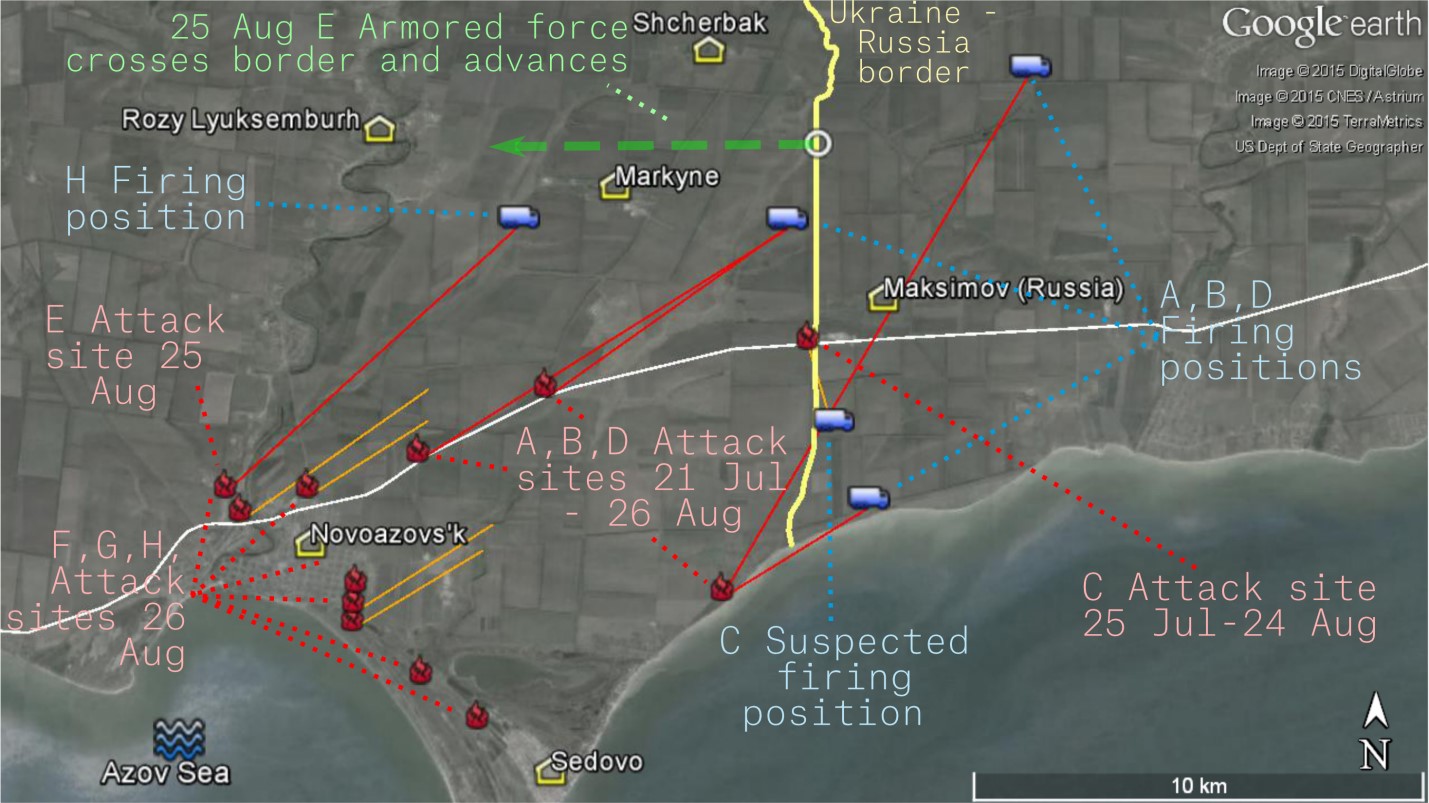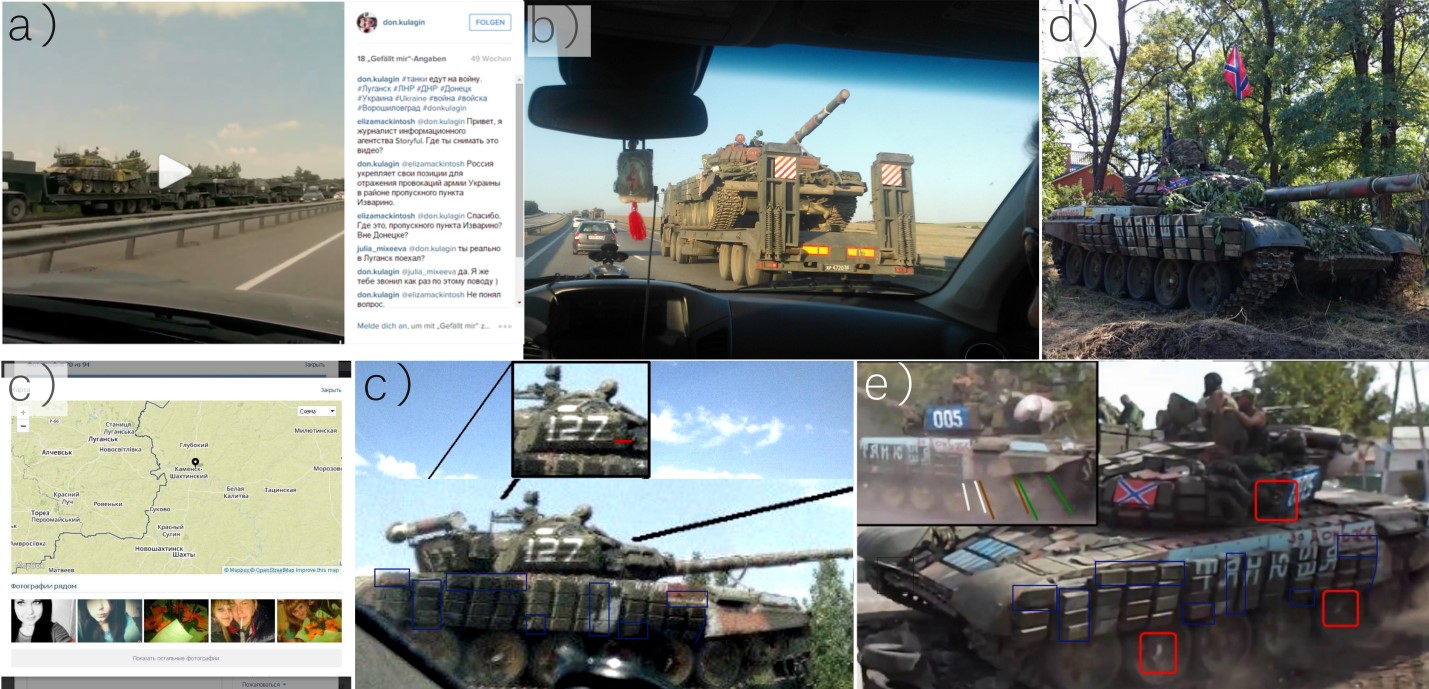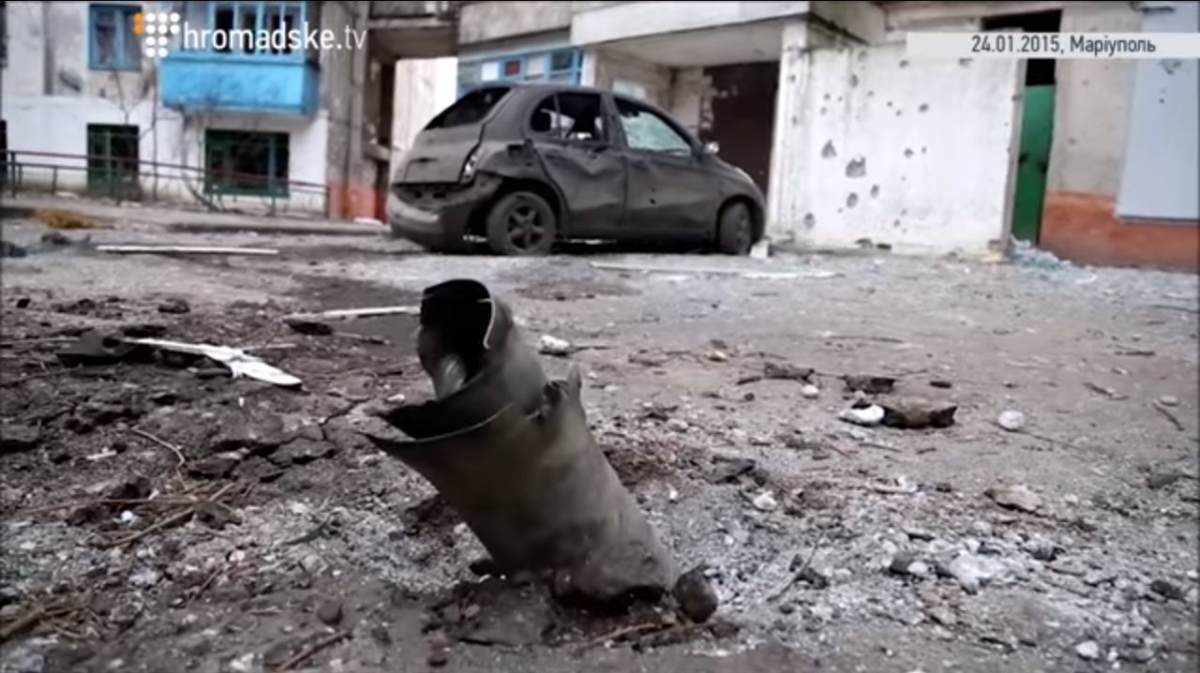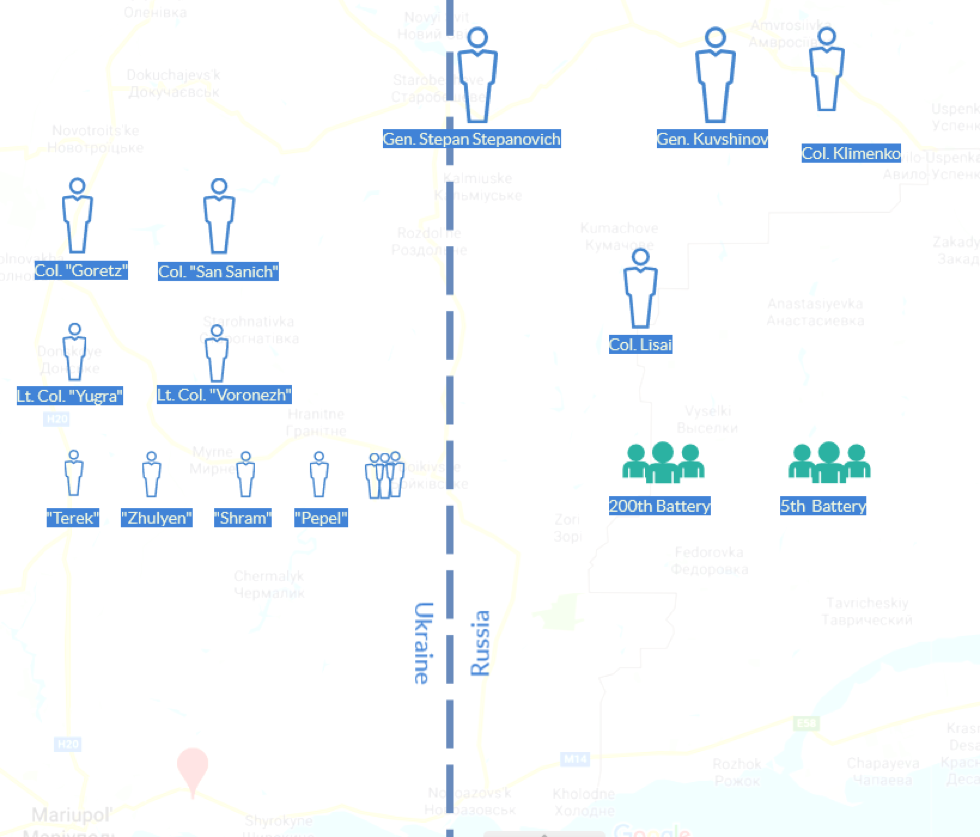The Burning Road to Mariupol: Attacks from Russia during the Novoazovs'k Offensive of August 2014
Download the full report here.
Данный отчет также доступен на русском языке.
Summary
This report investigates the claims of Russian involvement in the attacks leading up to and during the assault on Novoazovs’k between 23 and 27 August 2014. The report analyzes open source evidence to determine the source of artillery fire on Ukrainian units, as well as the origin of armored vehicles sighted inside Ukraine in the Novoazovs’k area.
Evidence from social media and satellite imagery shows that artillery attacks and armored vehicles sighted in the area of Novoazovs’k in July / August 2014 came from Russia (summarized in Figure 1 and Table 1). Two artillery attacks on 23 August 2014 came from Russian territory, and two T-72Bs and one 2s19 Msta-S sighted in Novoazovs’k after its capture were transported from Russia. The report also provides analysis of other attacks in the Novoazovs’k area during July / August 2014, several with some (but not conclusive) evidence suggesting attacks from Russian territory.

Figure 1. Summary of artillery attacks in the Novoazovs’k region, from 21 July to 26 August 2014. Red solid lines indicate the trajectory of artillery fire that has been matched to a firing point found from satellite or social media evidence. Orange lines indicate a trajectory estimated from photo or video at the attack site – the firing point is unknown. The green line indicates the movement of attacking forces after advancing across the border on 25 August 2014.
In mid-August 2014, Ukrainian armed forces had pushed back the Russian-armed separatist forces to the areas close to the cities of Donetsk and Luhansk. Until this time, the area of the Donetsk region close to Novoazovs’k and Mariupol, overlooking the Sea of Azov, had been spared the worst of the fighting. Before 23 August 2014, Ukrainian forces had sporadically come under artillery fire (on 21 July, 25 July, 21 August); however, there were no clear signs of forces massing in the area at the time to threaten a large-scale attack. This changed on the morning of 23 August 2014, with large-scale and frequent artillery attacks on Ukrainian positions close to Novoazovs’k border crossing point (BCP), which continued over the next few days. By the morning of 25 August 2014, it was clear that towns along the Azov coast were now targets of the Russian-armed separatist forces.
Using evidence from social media and satellite imagery, primarily from Yandex maps images from 31 August 2014, Google Earth images from October 2014 and TerraServer images from 2014 – 2015, we show that artillery attacks and armored vehicles sighted in the area of Novoazovs’k in July / August 2014 came from Russia. On 23 August 2014, Multiple Launch Rocket System (MLRS) fired from Russian territory struck a Ukrainian military base close to the town of Kholodne; more than 30 kilometers from the nearest position of the Russian-armed separatist forces within Ukraine. Soon after, another artillery system within Russia struck the same position. Later, two Ukrainian checkpoints on the road from Novoazovs’k border crossing point (BCP) to Novoazovs’k town were attacked by MLRS fire from a firing position less than one kilometer from the Russian border, with visible tracks leading back to a crossing point into Russian territory, and/or from a position within Russia.
On 25 August 2014, satellite imagery evidence supports media reports and witness testimony that Russian-armed separatist forces crossed into Ukraine through a crossing point (visible on satellite imagery) north of Novoazovs’k BCP, and attacked Ukrainian forces to the east of the town of Novoazovs’k. On 25-26 August 2014, videos and photos show the aftermath of MLRS and artillery shelling of roads, houses, a cemetery, a bread factory and a hospital as Russian-armed separatist forces fought to take control of the town of Novoazovs’k.

Figure 2. Sightings of tank number 127 / 005 in Russia and Ukraine during the summer of 2014. a), c) in a truck convoy 30 July 2014 close to Kamensk-Shakhtinsky [1] [1-archive] [2] [2-archive] [2-geolocation] [2-geolocation-archive] . b) Another convoy carrying tank 127, photo uploaded on 21 August 2014 and taken in the area of Rostov-on-Don [3] . d) A photo of tank 127 in Novoazovs’k taken by journalist Petr Shelomovskiy on 31 August 2014 [4] [4-archive] . e) A photo of tank 127 in video CONVOY-2 uploaded 10 September 2014, filmed at 47.126085, 38.084023 [5] [5-archive].
In summary, open source evidence shows that attacks on Ukrainian forces around Novoazovs’k came from Russia, and vehicles used in the conflict in the area were transported from Russia. This report adds to the growing body of evidence showing that Russia was directly involved in the Ukrainian conflict of 2014-2015.
Table 1. A summary of the incidents and evidence investigated in this report. [6] [6-archive] [7] [7-archive] [8] [8-archive] [9]
| Attack name | Date | Source of fire | Evidence |
| A. MLRS attack on Kholodne | 23 August 2014 | Russia | Video of rocket launch. Video of Kholodne under attack. Firing point and attack craters located on satellite images. |
| B. Self-propelled artillery shelling of Kholodne | 23 August 2014 | Russia | Video of artillery firing site. Video of Kholodne under attack. Firing point located on satellite images. Trajectory analysis of artillery fire. |
| C. Mortar shelling of Novoazovs’k border crossing point | 25 July – 24 August 2014 | Russia (unconfirmed) | Potential firing site located on satellite images. Witness reports. |
| D. MLRS and artillery shelling of checkpoints on road to Novoazovs’k | 21 July, 23 – 27 August | Inside Ukraine, Within 1 kilometer of Russian border | Firing site located, and vehicle tracks leading back to Russia. A second potential firing position identified in Russia. Artillery trajectories determined from photos taken at attack sites. Crater trajectory analysis of satellite imagery at attack site. |
| E. Armored assault from Russia on Novoazovs’k area | 25 August 2014 | Crossed border from Russia between Markyne and Shcherbak, advanced on Novoazovs’k | Witness reports. Border crossing point, route of vehicle convoy and subsequent battle identified on satellite images. |
| F. MLRS attack on Sedovo – Novoazovs’k road | 26 August 2014 morning | Ukraine or Russia northeast of Novoazovs’k – unknown | Videos / photos of the attack site shortly after the attack. Crater trajectories analyzed from photos / video. |
| G. Bread factory northeast Novoazovs’k artillery strike | 26 August 2014 morning | Ukraine or Russia northeast of Novoazovs’k – unknown | Videos / photos of the attack site during and shortly after the attack. Crater trajectories analyzed from photos / video. |
| H. Northwest Novoazovs’k artillery strike | 26 August 2014 afternoon | Ukraine – northeast of Novoazovs’k in are southeast of Rozy Lyuksemburh | Videos / photos of the attack site during and shortly after the attack. Crater trajectories analyzed from satellite images. Potential firing point located. |
| I. Presence of 2 x T-72Bs and 1 x 2s19 MSTA from Russia inside Ukraine | 27 August to early September | NA | Videos and photos of convoys in Russia with matching vehicles sighted in Ukraine |
Acknowledgments
This report was written by Sean Case and Klement Anders, with significant contributions from Aric Toler and Eliot Higgins.
The following members of the Bellingcat Investigation Team also contributed to this report:
- Timmi Allen
- Andrew Haggard
- Pieter van Huis
- Veli-Pekka Kivimaki
- Iggy Ostanin
- Nathan Patin
- Daniel Romein
Thanks to Pavel Aleshin and Dmitry Bochkov for assistance with the translation to Russian.

